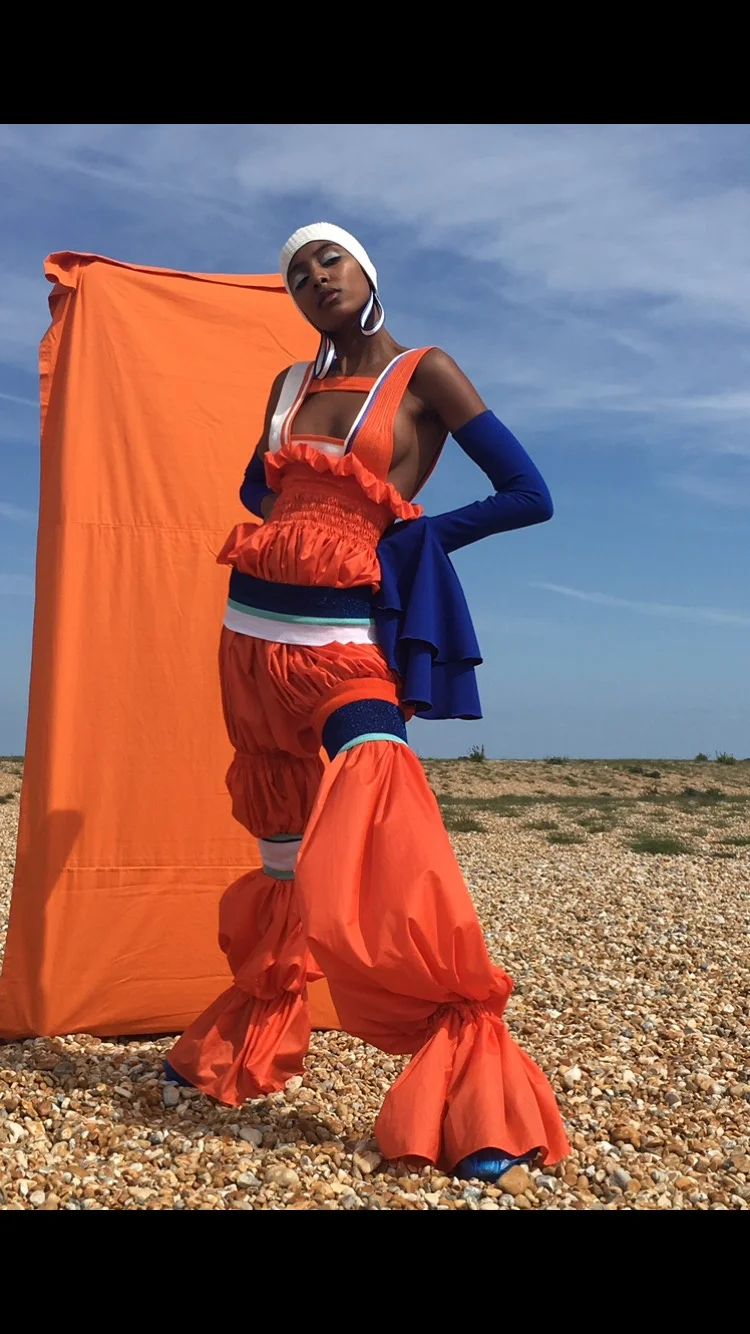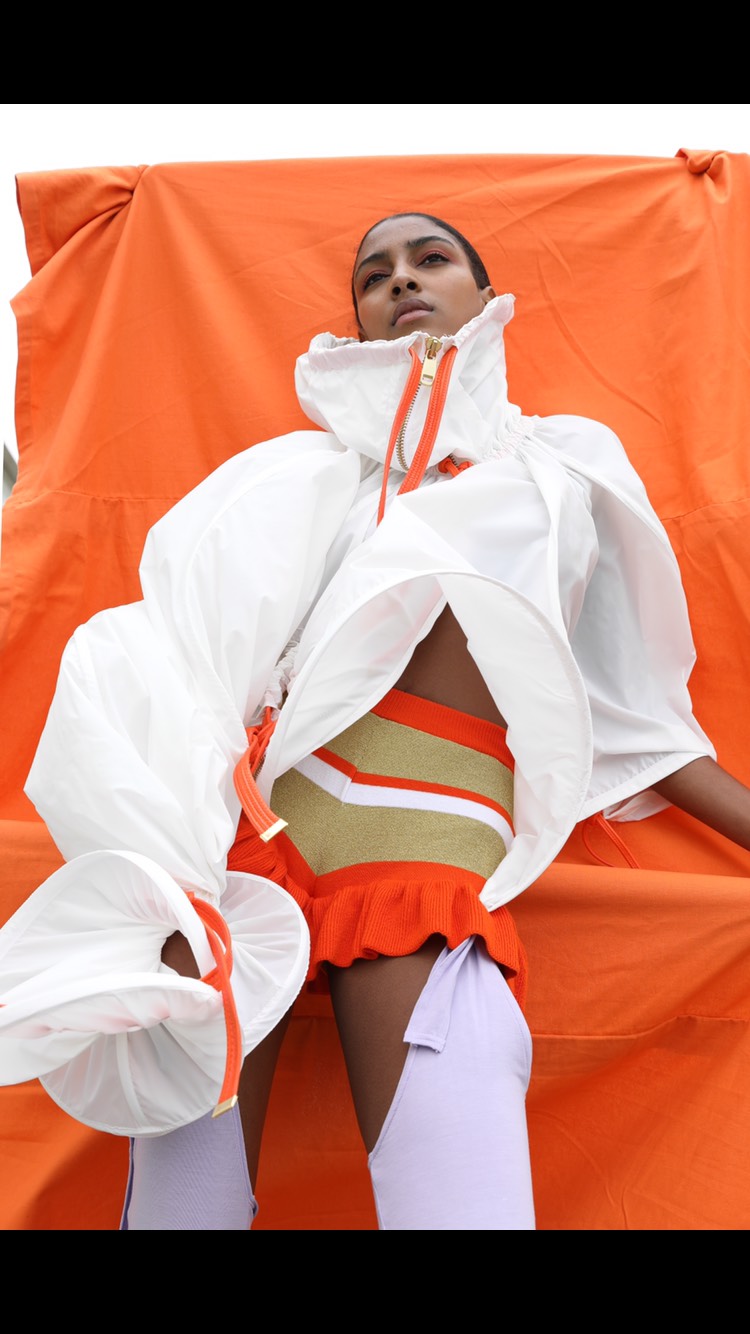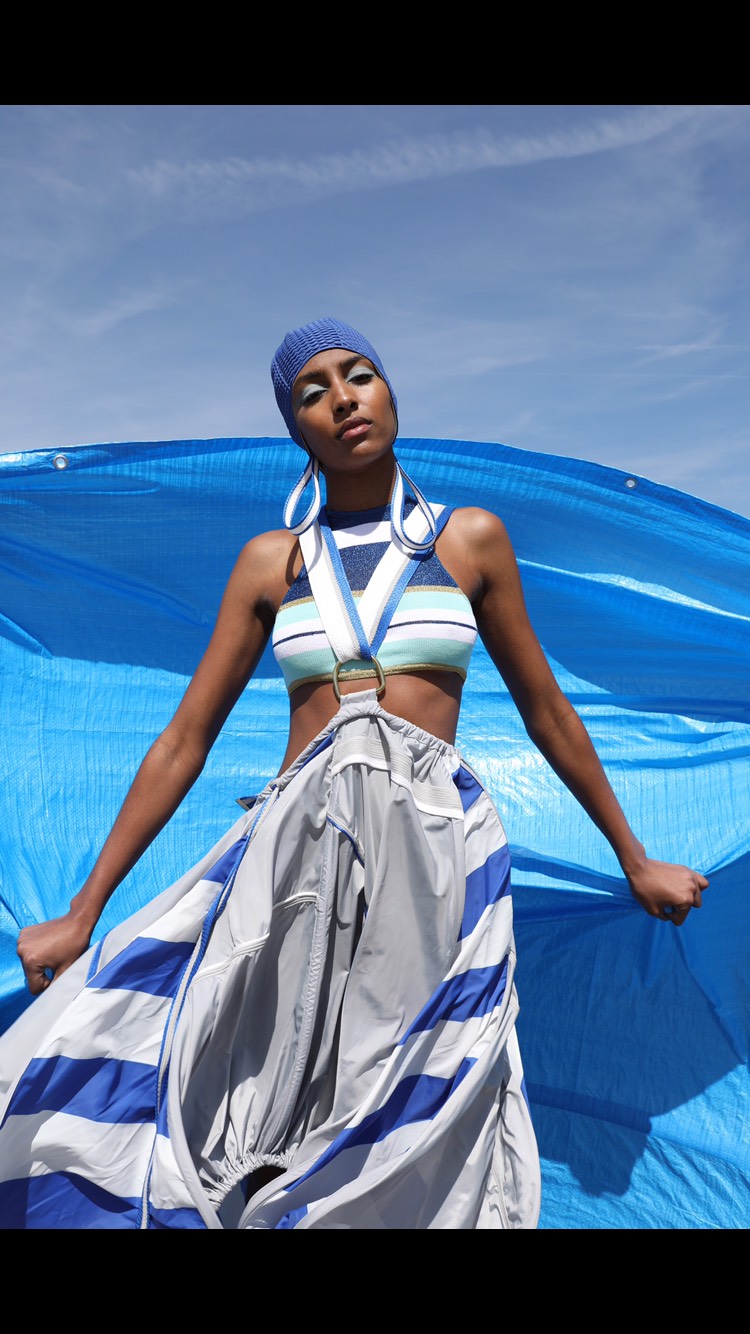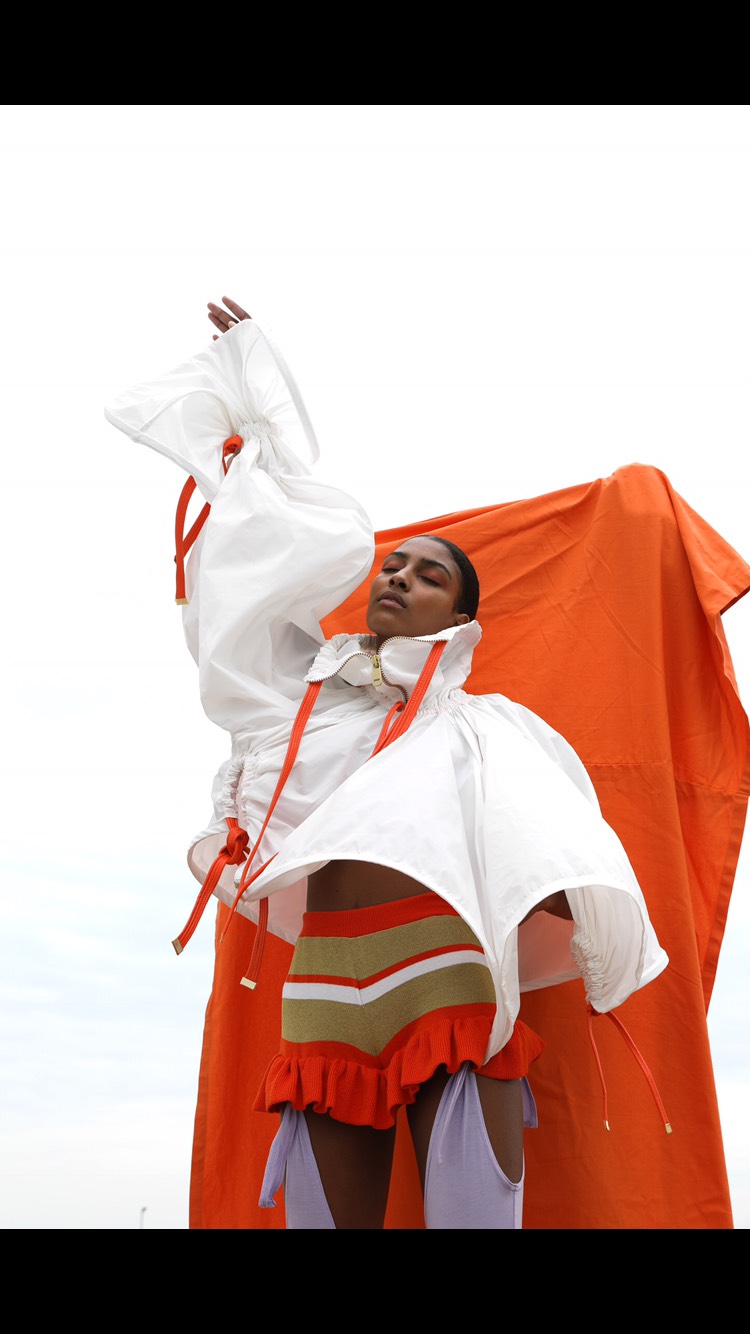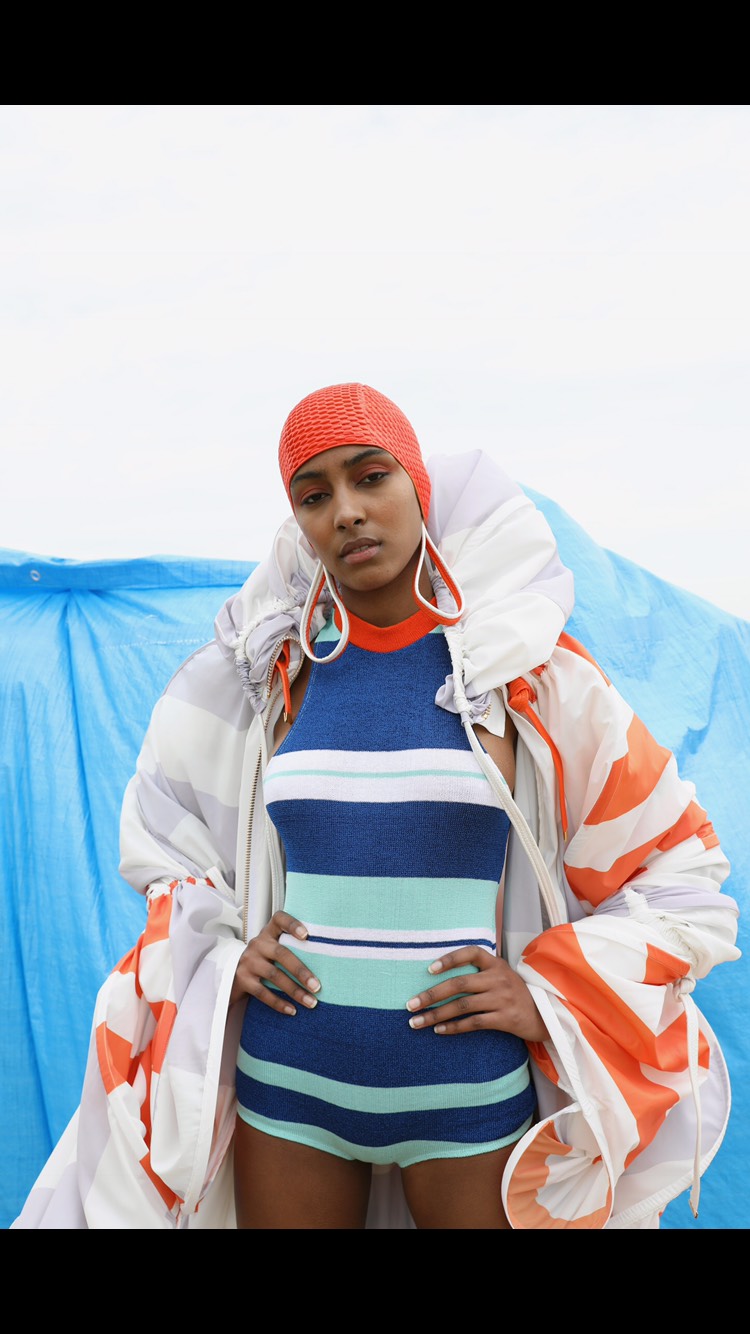From the naive structures of children building forts to 1970's Japanese architecture, Martha Ketcher, developed her final collection around the notion of shelter, protection and tension. Seeking to bring design methodology in line with the adaptable culture of today's society, Martha's work is original like no other - using contemporary notions of a generation that refuses to put down roots as a starting point for her pieces.
In line with the industry's focus on sustainability, Martha designed her pieces with an awareness of extreme and unpredictable weather conditions that climate change has created. We caught up with the University of Brighton graduate to hear more about how her university experience taught her to trust her creative judgement, why 1980's clubwear and beach silhouettes are the basis for her aesthetic and why wearable shelters are the way forward.
Which university did you attend and what was the most valuable thing you learnt there?
I attended the University of Brighton and the most valuable thing I learnt was how to undergo very technical yet highly creative pattern cutting methods to achieve professional and unique designs. One of the best things I was taught at my university was also to trust my creative judgement but also to keep certain design ideas simple and not over complicate everything, which I have a tendency to do! And also how to translate my 2D ideas into a 3D sense, using unique fabric draping/constructing methods on the stand to create different silhouettes.
Describe the inspiration and concept behind your work.
The concept behind the collection was initially inspired by the idea of wearable shelters, and people’s haphazard approaches to very basic forms of shelter and how they protect themselves from the elements like sun, wind or rain using inside out umbrellas, newspapers, bags or towels as makeshift shelters. I drew on personal research, looking outside fashion to the everyday, using vintage and contemporary photography to inspire.
My design references drew from stripy beach umbrellas, wind breaks, tents, sun canopies and sheets blowing in the breeze. I noticed contrast between the lightweight, billowy volume created by boned tents and sheets, compared to the tight sleeves or ties pulled over beach umbrellas or bunkered down tents. This idea of tension then became a vital design feature, and I drew similarities between the beach silhouettes and 1980s club wear, from the likes of BodyMap and Leigh Bowery’s avant-garde costumes.
From here, I started recreating these protective shapes by using boning in unconventional methods, as if I were actually constructing vast, wearable beach umbrellas or parachutes. I then drew on Bodymap’s clubwear and stripy beach towels and windbreaks, to create fine, stripy, bodyfit, knit pieces to trap lightweight, billowing shapes underneath. The collection is based on wearable shelters and basic forms of protection, but dressed up in a light, beach inspired, summery, playful manner.
Graduate Fashion Week provides a platform for emerging fashion graduates to showcase their work regardless of the specific discipline. Which area of the industry are you hoping to peruse?
At the moment, I am just happy to be involved in the fashion industry as a high street womenswear design assistant. But in the future, I hope to be involved in high end sportswear inspired womenswear or sport-luxe. I have always had a keen interest in designing sporty silhouettes and relaxed, casual fits, which have been even more realised in my graduate year when designing my final collection.
Do you explore any political, social or historical notions through your work? If so, what messages do you hope to convey?
I hope to convey social notions of protection, shelter and insular living through my work. My inspiration began by looking into 1970s Japanese architecture, also known as metabolism. This included ‘pod’ living, and I became fascinated by the idea of insular living, and began looking at childhood and how children build forts and dens for shelter.
Developing on from this, I started researching wearable shelters and how one’s garments could be used as both fashion and protection. I feel like this concept is more relevant than ever in this age of portability and mobility, where everything is instant and nobody stays in one place anymore. Nothing is long term, everyone rents and no one buys, people hold down multiple jobs and we’re always on the go. I think fashion needs to progress with this new society, so I created a collection that accommodates this, by wearing lightweight, fun, yet protective clothing that can also be used as shelter.
Many say that the industry is undergoing a huge change, with sustainability, diversity and responsibility becoming huge themes. Do you have any opinions on these movements?
I think sustainably is something we should all be more aware of and striving for, especially with fast fashion growing as rapidly as it is. I have always been taught from a young age to not be wasteful when it comes to clothing, and buy good quality pieces that I will wear for years and years, as opposed to buying bags and bags of cheap clothes without much thought and then throwing them away when they’re not right. That’s not what fashion is about.
I explore environmental issues in my work by looking into the rise of global warming and freak weather conditions. I therefore, created a collection that could adapt to various conditions like extreme sun or wind, and also be worn all year round, rather than seasonal fashion.
What one thing would you recommend our readers do whilst at the event?
I would recommend people visit as many university stands as possible and browse through all the portfolios on display. The portfolios are absolutely fascinating, as you get a real sense for the mood and themes behind someone’s collection. I find that the portfolios are sometimes even more interesting than seeing the collections on the catwalk because you get to see all the thought, research, development and general work that goes into making a collection.
Where are you hoping to be in 5 years time?
In 5 years time, I would love to be designing for a vibrant, high-end, sporty brand like Y Project, Stella McCartney or a Kenzo. But I would still like to try to continue with freelance work occasionally, creating new designs and garments for clients. Even though I know I want to work in a design team for a brand I admire as opposed to starting up my own line, I still think designing your own garments is important.
If you could give one piece of advice to yourself in first year, what would it be?
I would tell myself to just have fun with designing and not to worry so much about trying to achieve perfection or a top grade. The idea of the fashion industry was still quite scary to me when I was in first year but it’s important to keep on reminding yourself that’s it’s just clothes! I came into fashion from a fine art based background so I had the creativity but no technical skills. But fashion schools are looking for students from all sorts of different backgrounds so it’s good to start with the creativity and the technical making will come with time, the tutors aren’t expecting the finished article.
Photographs provided by Martha Ketcher
Interview by Annabel Waterhouse-Biggins


